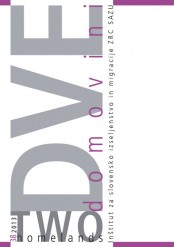Urejanje mobilnih življenj: Marginalizirani Maročani v transnacionalnem prostoru
Keywords:
transnational mobility, irregular migration, Morocco, survival strategies, economic marginalizationAbstract
The article traces, by means of extended ethnographic participant observation, the cultural construction of a particular type of male marginal mobility, namely that of economically marginalised Moroccan migrant men. For these men, the departure from Morocco as irregular migrants to Europe appeared as a means to escape a life without a horizon. They faced lethal dangers during their journeys across the Strait of Gibraltar in small open boats, and Spain appeared unwelcoming to them, since the traditional sector of migrant labour, industrial work, could no longer absorb them. These men had very few other options than to invest in transnationalising the distinctive ethos of dabbar, i.e. ‘arranging’ survival strategies and social relations in the unregulated and lowest echelons of the labour market in Spain. For a large number of these Moroccans, permanent EU residence and citizenship turned into means of broadening the sphere of dabbar. Many of these men currently engage in transnational trading activities of second-hand goods, including small electronic devices, shoes and clothes and household utensils.
Downloads
References
Al-Qabab, Muhammad (1998). Al hijra s-sirriya. [The Hidden Migration]. Unpublished presentation at the International Seminar on Human Rights and the Moroccan Migrant Community Abroad, Tangiers, Morocco 23–26 November 1998. Moroccan Ministry of Human Rights.
Driessen, Henk (1998). The New Immigration and the Transformation of the European – African Frontiers. Border Identities: Nation-state and International Frontiers (eds. Thomas Wilson, Donnan Hastings). Cambridge and New York: Cambridge University.
Gilsenan, Michael (1996). Lords of the Lebanese Marches: Violence and Narrative in an Arab Society. Berkeley: University of California.
Lopez Garcia, Bernabe (1996). La evolución del orígen de los inmigrantes Marroquíes en España. Atlas de la Inmigración Magrebí en España. Madrid: Universidad Autónoma de Madrid y Ministerio de Asuntos Sociales, Dirección General de Migraciones.
Nini, Rachid (2002). Diario de un ilegal. Madrid: Oriente y Mediterráneo.
Ogden, Phillip (1991). Immigration to France since 1945: Myth and Reality. Ethnic and Racial Studies 14/3, 294–318.
Salih, Muhammad (1996). Min Faqih Ben Salih ila Milano: Al hijra d-duwaliya al maghribiya ila Italiya wa ta’thiruha ´ala manātiq l-intilāq. [From Faqih Ben Salih to Milano: Moroccan Migration to Italy and its Eff ects on the Sending Areas]. Rabat: Muhammed V University, Faculty of Humanities.
Sørensen Nyberg, Ninna (2000). Crossing the Spanish-Moroccan Border with Migrants, New Islamists, and Riff -Raff . Ethnologia Europaea 30/2, 87–100.
Vale de Almeida, Miguel (1996). The Hegemonic Male: Masculinity in a Portuguese Town. Providence and Oxford: Berghahn Books.
Yaghmaian, Behzad (2005). Embracing the Infi del: Stories of Muslim Migrants on the Journey West. New York: Delacorte Press.
Downloads
Published
How to Cite
Issue
Section
License

This work is licensed under a Creative Commons Attribution-NonCommercial-NoDerivatives 4.0 International License.
Authors guarantee that the work is their own original creation and does not infringe any statutory or common-law copyright or any proprietary right of any third party. In case of claims by third parties, authors commit their self to defend the interests of the publisher, and shall cover any potential costs.
More in: Submission chapter





